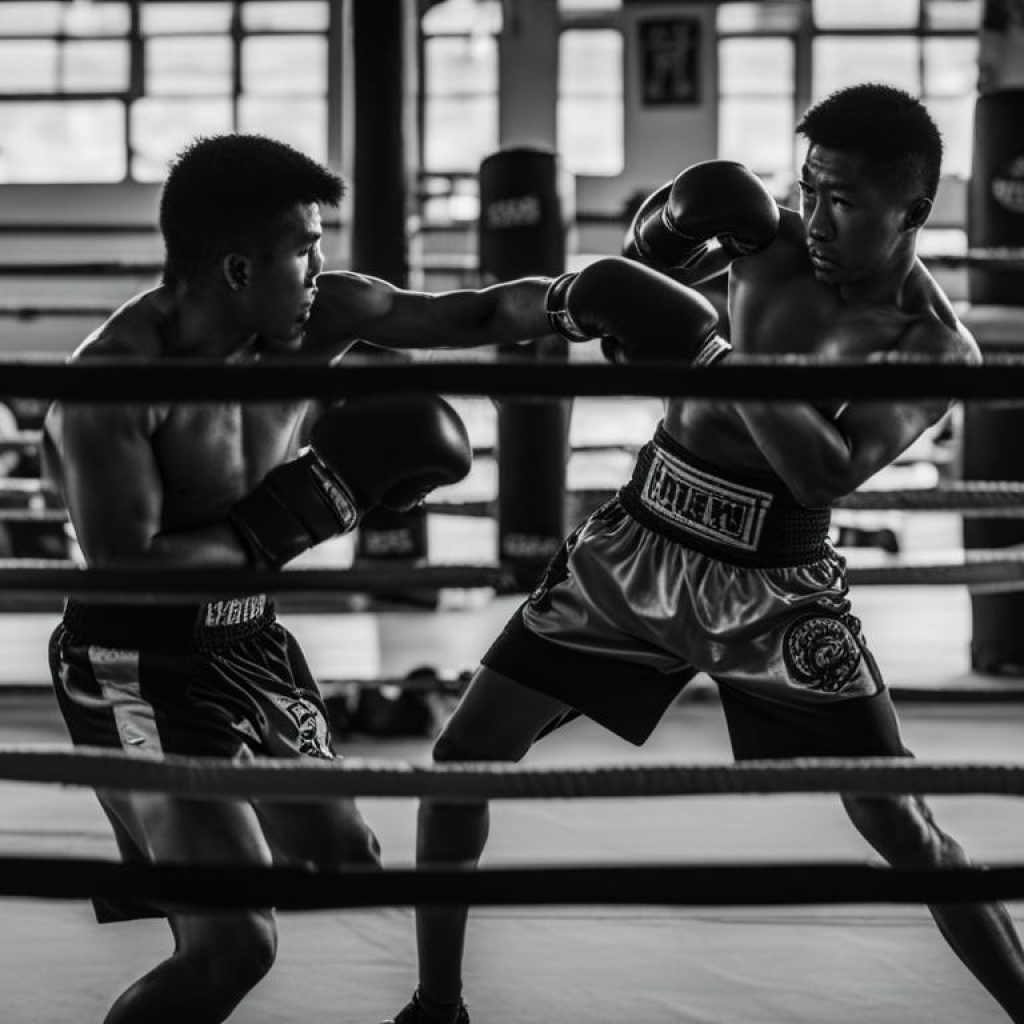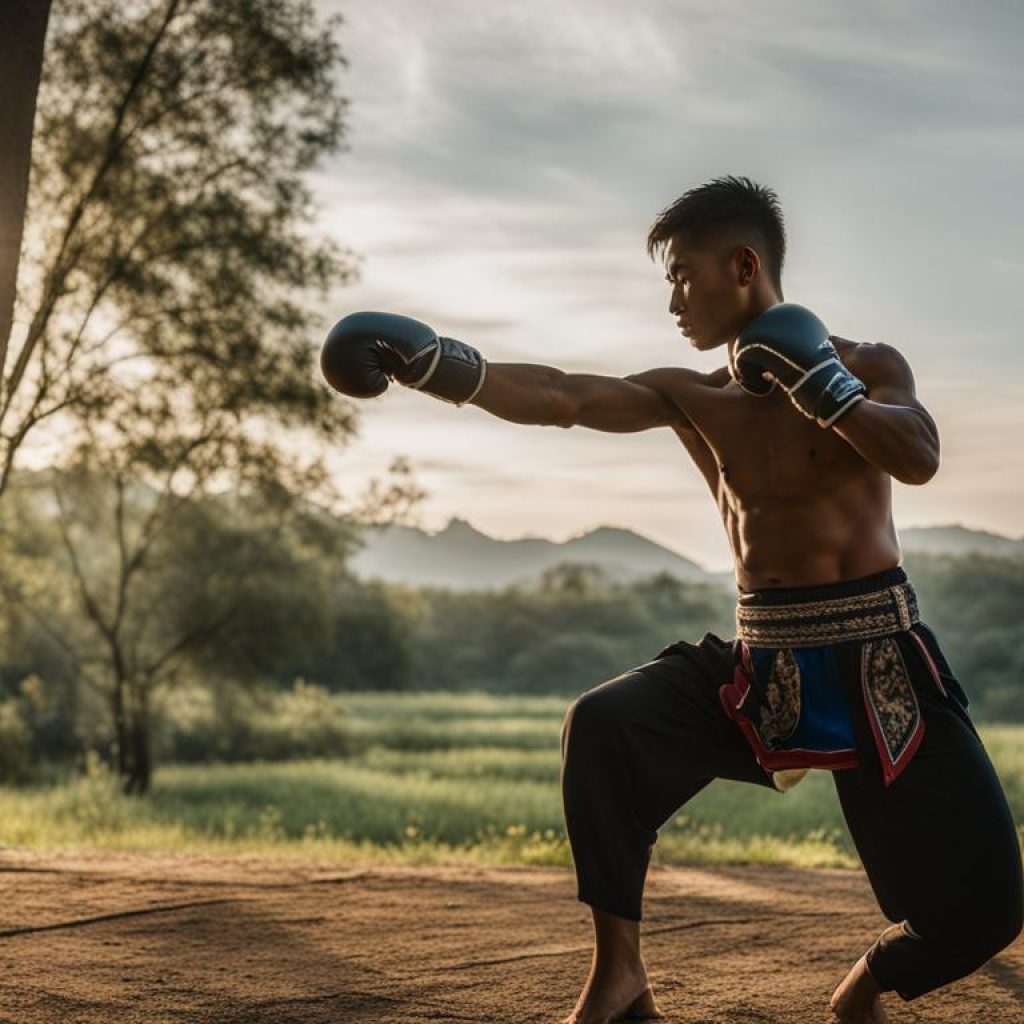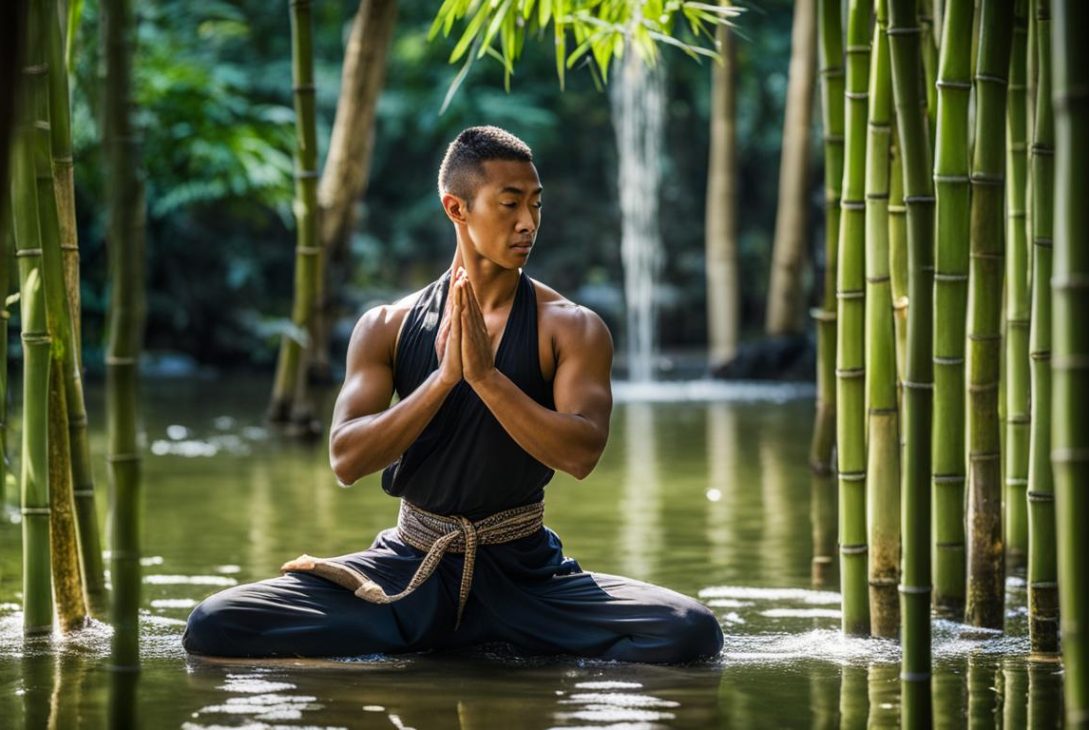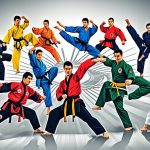Personal Note:
A long time ago, one of my instructors made a remark that has resonated with me for two decades. I am trying to remember the context exactly, but he had paired the class up, one with gloves, the other with focus mitts, and we were trading off every 5 min. Someone got injured; they had been hit by accident in the side of the face instead of the mitt. One of the other students remarked, “Well, that’s what you get when you don’t flow the pads with the striker.” I understood what he meant; you always meet the hits with the pads part way, and though it is true, they said it with such a lack of sympathy, I could tell our Khru was bothered by it; he said, “In Martial Arts, it is really easy to hurt people, maybe you should try to heal people as well.
He was refrancing the need for balance! He explained that Modern-day warriors need balance just as those in the past. The Samurai practiced calligraphy and Banzi as an example, and we must do the same!
As for myself, I find solace in empathy for my fellow man; I love helping people in any way I can, I take comfort in trying my best to find balance in my life, I love Martial Arts of all kinds, but I love many other things as well!
The effort for us all to find balance as fighters and warriors is a very personal journey, and from me to you, “I hope your journey is a blessed one!”.
I want to dive deep into the world of martial arts and explore how it goes beyond self-defense. Contrary to popular misconception, martial arts is not just about inflicting harm; it is a powerful tool for personal growth, self-healing, and holistic well-being.
Through the practice of martial arts, individuals can learn to cultivate strength that protects rather than harms. The meditative presence of martial movement allows practitioners to forge a mindful relationship with violence itself, transforming inner aggression into disciplined action. Even beginner drills can strengthen focus and self-control.
Join me on this journey as we delve into the healing techniques in martial arts and discover how it can foster personal growth and empower individuals to become protectors and peacemakers. Let’s explore the transformative power of mindful movement, the resilience gained through sparring, and the cultivation of empathy alongside power. We will also uncover how martial arts training helps individuals stay calm within turmoil and transforms inner aggression into creation.
- Martial arts is a powerful tool for personal growth and self-healing.
- By cultivating strength and discipline, martial arts practitioners learn to control aggression without inflicting harm.
- Mindful movement in martial arts improves concentration, focus, and emotional well-being.
- Sparring in martial arts enhances resilience and the ability to regulate fight arousal.
- Martial artistry promotes responsible use of force, compassion, and peacemaking.
The Transformative Power of Mindful Movement
Mindful movement lies at the heart of martial arts training. Unlike mindless brawling, martial arts require deep focus and concentration to execute techniques with precision. Through dedicated practice and immersion in this flow, practitioners not only enhance their performance but also experience profound benefits in their daily lives.
Martial arts training enables individuals to develop improved concentration and heightened awareness, leading to holistic well-being.
Studies have shown that engaging in martial arts strengthens the brain areas associated with emotional regulation and attention control. This means that the practice of martial arts can enhance emotional well-being and promote greater discipline and focus.
By cultivating discipline and focus through mindful movement, individuals can develop essential life skills that extend beyond martial arts training itself. The ability to stay present and focused in the midst of challenging situations becomes a transferable skill that can be applied to various aspects of life, such as work, relationships, and personal goals.
Furthermore, the physical aspect of martial arts training contributes to improved physical fitness. The rigorous nature of techniques and movements helps practitioners build strength, flexibility, and endurance, fostering a well-rounded level of fitness.
Mindful movement in martial arts is not merely about the physical aspect; it is a practice of mental and emotional discipline as well. The process of mastering techniques requires perseverance, resilience, and a willingness to overcome obstacles. Through this journey, martial arts practitioners develop greater self-discipline, self-control, and self-awareness.
The Emotional and Cognitive Benefits of Mindful Movement
The practice of mindful movement in martial arts offers numerous emotional and cognitive benefits, including:
- Increased stress resilience
- Enhanced emotional intelligence
- Improved self-confidence
- Greater ability to manage and regulate emotions
Through mindful movement, individuals learn to navigate challenging emotions, such as fear and anger, with poise and control. This emotional resilience becomes an invaluable tool for managing stress and maintaining emotional well-being in daily life.
Moreover, the focus and discipline required in martial arts training cultivate a heightened sense of self-awareness and emotional intelligence. By learning to observe and understand their own emotions, practitioners develop the ability to empathize with others and build healthier relationships.
“Martial arts training is not just about physical techniques; it is a journey of self-discovery and personal growth.” – Master Kenji Yamamoto
Martial arts enable individuals to develop discipline and focus through the practice of mindful movement. This holistic approach to training fosters emotional well-being, physical fitness, and a greater sense of self-awareness. By embracing the transformative power of martial arts, individuals can embark on a journey of self-discovery, personal growth, and inner peace.
| Benefits of Mindful Movement in Martial Arts | Benefits |
|---|---|
| Stress Resilience | Increased ability to manage and cope with stress |
| Emotional Intelligence | Enhanced understanding and regulation of emotions |
| Physical Fitness | Improved strength, flexibility, and endurance |
| Discipline and Focus | Enhanced self-discipline, concentration, and mental clarity |
Resilience Through Sparring
Sparring is a fundamental aspect of martial arts training, providing an opportunity to develop stress resilience, regulate fight arousal, and enhance overall combat skills. Through repeated engagement in controlled fight scenarios, practitioners learn to evoke and manage fight physiology, such as adrenaline surges and heightened arousal.
During sparring sessions, the body experiences the physical and emotional responses that mimic a real fight, allowing practitioners to practice controlling and channeling these intense sensations. This exposure/recovery cycling gradually grooves regulation pathways at a somatic level, enabling individuals to voluntarily switch on and off fight arousal in everyday contexts.
This ability to regulate fight arousal contributes to increased resilience in the face of stress. By honing the mind-body connection and fine-tuning their response to fight scenarios, martial artists develop the capacity to remain calm and centered amidst chaos.
Sparring also serves as a form of fight training, allowing practitioners to test their techniques, timing, and strategy against live opponents. It provides an opportunity to refine defensive skills, improve situational awareness, and build confidence in one’s abilities.
Sparring allows me to push myself beyond my limits and face the challenges head-on. It helps me become more resilient both physically and mentally, and prepares me for any real-life situation that requires quick thinking and decisive action.
Benefits of Sparring
Sparring offers a range of benefits that extend beyond physical combat skills:
- Enhanced Stress Resilience: Regular sparring exposes practitioners to controlled stress, helping them develop the mental and emotional fortitude to handle high-pressure situations.
- Improved Reaction Time: Sparring hones reflexes and trains the body to respond swiftly and effectively to attacks, enhancing combat readiness.
- Heightened Situational Awareness: By engaging in dynamic sparring scenarios, martial artists learn to assess and respond to changing circumstances, sharpening their ability to adapt in real-life situations.
- Greater Confidence: Successfully navigating sparring sessions instills a sense of accomplishment and builds self-assurance, bolstering overall confidence.
| Benefits of Sparring | Explanation |
|---|---|
| Enhanced Stress Resilience | Regular exposure to controlled stress during sparring strengthens the ability to cope with challenging situations. |
| Improved Reaction Time | Sparring drills develop reflexes and train the body to react quickly and effectively to attacks. |
| Heightened Situational Awareness | Dynamic sparring scenarios sharpen the ability to assess and respond to changing circumstances. |
| Greater Confidence | Successfully navigating sparring sessions boosts self-assurance and builds overall confidence. |
Training Empathy Alongside Power
Martial arts is not simply about physical prowess, but also about fostering responsible use of force and cultivating compassion. As martial artists, we understand that aggression often stems from trauma and toxic values that perpetuate suffering. It is our duty to address these root causes and promote healing instead of perpetuating harm.
True strength lies not in mindless brutality, but in skillfully defusing fights and resolving conflicts with compassion. We strive to defy the stereotype of thoughtless aggression by becoming protectors and peacemakers. Our martial artistry is dedicated to promoting compassion and justice in our communities.
“The highest result of education is tolerance.” – Helen Keller
By advocating for responsible use of force, we aim to create a world where violence is not celebrated, but rather minimized through understanding and empathy. We recognize that true power lies in the ability to control oneself and respond to conflicts with thoughtful consideration.
Through our training, we learn to harness our physical abilities and use them only when necessary, always prioritizing de-escalation and peaceful resolution. By cultivating empathy, we gain a deeper understanding of the impact our actions have on others and strive to minimize harm.
Peacemakers and Protectors
Martial artists are not just fighters; we are peacemakers and protectors. Our goal is to create a world where compassion and justice prevail over violence and aggression.
We believe that embracing martial arts goes hand in hand with embracing compassion. By training in responsible martial artistry, we develop the skills and mindset to handle conflicts peacefully and effectively. We are dedicated to promoting harmony within ourselves and in our interactions with others.
“Compassion is not a relationship between the healer and the wounded. It’s a relationship between equals.” – Pema Chödrön
Our commitment to compassion extends beyond the confines of the training mat. We strive to bring the principles of martial artistry into all aspects of our lives, advocating for justice, fairness, and the well-being of others. Through our actions, we aim to be role models and catalysts for positive change.

| Benefits of Training Empathy and Responsible Use of Force | How it Enhances Martial Artistry |
|---|---|
| 1. Promotes non-violent conflict resolution | 1. Enables effective de-escalation techniques |
| 2. Fosters understanding and empathy | 2. Enhances communication skills during sparring |
| 3. Builds strong connections within the martial arts community | 3. Cultivates a supportive and inclusive training environment |
| 4. Advocates for justice and fairness | 4. Transforms martial arts from self-defense to peacemaking |
Cultivating the Eye of the Storm
When it comes to martial arts training, one of the key lessons is learning to stay calm in the face of turmoil. This ability to remain composed and grounded is essential in developing unflappable strength and crisis awareness. By cultivating the eye of the storm, practitioners are equipped to effectively handle unexpected violence and navigate emergencies with composure.
Martial artists understand the importance of staying calm in tense situations. This calmness allows them to think clearly and make rational decisions, even in the midst of chaos. By learning to breathe into tension and control their body’s responses, martial artists are able to assess threats and take appropriate action with minimal harm.
The eye of the storm is not just a metaphorical concept; it’s a tangible state of being. Through rigorous training and discipline, martial artists develop a heightened somatic awareness that enables them to tap into their instincts and stay present in the moment. This somatic feeling below mental panic helps individuals maintain their composure and navigate through challenging situations effectively.
It’s important to note that the ability to stay calm and composed extends beyond the training mat. Martial artists apply this mindset to all aspects of life, whether it’s dealing with personal crises, workplace challenges, or everyday stressors. The skills and mental resilience developed through martial arts training become a prevailing force that empowers individuals to face any turmoil with unflappable strength.
Transforming Inner Aggression
Martial training offers a transformative path for healing deep-seated anger and channeling it into constructive outlets. By embracing discipline and self-control, individuals gain the power to regulate and transcend their most intense emotions. Through dedicated practice, martial artists learn to sublimate destructive impulses into creative actions, fostering personal growth and self-awareness.
The Healing Power of Discipline
Discipline is the key to transforming inner aggression. By committing to a rigorous martial arts practice, individuals develop the ability to control their impulses and emotions. The structured nature of martial training serves as a foundation for cultivating discipline, which helps individuals build resilience and make conscious choices when confronted with anger and rage.
Channeling Rage Into Constructive Action
Martial arts provide a safe and controlled environment for individuals to channel their rage and pain into focused and disciplined action. Rather than suppressing or repressing these powerful emotions, martial artists learn to harness them, using their energy and intensity to fuel their training and personal growth.
“Through the practice of martial arts, I have been able to transform my anger and channel it into something positive. It has given me a sense of control and purpose that I never had before.” – Sarah, martial arts practitioner
Shadow Integration and Personal Growth
Shadow integration is an ongoing journey of embracing and integrating the darker aspects of ourselves. Martial arts practice provides a unique platform for shadow integration, as it allows individuals to confront and explore their inner demons in a safe and controlled environment. By acknowledging and working with the shadow, martial artists can achieve deep personal growth and transformation.
Training becomes a means of transcending the darkness that resides within every individual. By facing and integrating their shadow, martial artists are able to embody a more balanced and harmonious version of themselves, fostering healing and self-discovery.
The Path to Healing Anger
| Steps | Benefits |
|---|---|
| 1. Acknowledge anger | – Increased self-awareness – Ability to address underlying issues |
| 2. Embrace discipline | – Enhanced self-control – Cultivation of resilience |
| 3. Channel rage into training | – Outlet for intense emotions – Focused and constructive action |
| 4. Integrate the shadow | – Personal growth and transformation – Embracing one’s full potential |
Trauma-Informed Martial Arts: A Path to Healing
Trauma-informed martial arts programs have emerged as a powerful tool for healing and empowering trauma survivors. These programs provide a safe and supportive environment for individuals who have experienced trauma, offering an alternative to traditional self-defense workshops. By incorporating trauma-informed practices within the framework of martial arts, these programs focus on reclaiming power and control over one’s own body, building confidence, and fostering a greater mind-body connection.
One such program is trauma-informed Brazilian jiu-jitsu, which combines the techniques of jiu-jitsu with trauma-informed principles. Participants learn to use leverage and technique to defend themselves, emphasizing empowerment and building resilience. Another example is trauma-informed kickboxing, which incorporates high-intensity interval training and grounding techniques to help individuals release stored emotions and reconnect with their bodies.
These trauma-informed martial arts programs go beyond physical self-defense and offer a holistic approach to healing. They promote a greater understanding of the mind-body connection and provide tools for trauma survivors to regain a sense of control and mastery over their bodies. By engaging in martial arts within a trauma-informed framework, individuals can experience a transformative journey of healing, personal growth, and empowerment.

The Mind-Body Connection in Trauma-Informed Martial Arts
One of the key aspects of trauma-informed martial arts is the emphasis on the mind-body connection. Through mindfulness practices and intentional movement, participants learn to connect with their bodies and become more aware of their thoughts, emotions, and physical sensations. This mind-body awareness allows trauma survivors to develop a greater sense of self-control, grounding, and presence in the moment.
By incorporating trauma-informed practices within the framework of martial arts, these programs focus on reclaiming power and control over one’s own body, building confidence, and fostering a greater mind-body connection.
Studies have shown that trauma-informed martial arts can have a positive impact on individuals’ mental and emotional well-being. The mindful movements and focused discipline involved in martial arts training can help trauma survivors regulate their emotions, reduce symptoms of anxiety and depression, and improve overall mental health.
Building Confidence and Empowerment
For trauma survivors, regaining a sense of confidence and empowerment is often an important step in the healing process. Trauma-informed martial arts programs provide a supportive environment where individuals can challenge themselves, set goals, and achieve personal milestones. This sense of achievement and mastery can have a profound impact on participants’ self-esteem and belief in their own abilities.
Through martial arts training, trauma survivors learn to trust their bodies and develop skills that enable them to protect themselves. This newfound confidence can extend beyond the training mat and into other areas of their lives, helping trauma survivors navigate challenges and build resilience.
The Trauma-Informed Approach
What sets trauma-informed martial arts apart is the recognition and understanding of the impact of trauma on individuals. Trained instructors create a safe and inclusive environment where trauma survivors can feel empowered and supported in their healing journey.
By integrating trauma-informed principles into their teaching, instructors prioritize safety, autonomy, and respect for each individual’s boundaries. They recognize the importance of consent and provide trauma survivors with tools to manage triggers and create a sense of agency in their training.
The Power of Trauma-Informed Martial Arts
Trauma-informed martial arts programs offer trauma survivors a unique path to healing and empowerment. By combining the physical techniques of martial arts with trauma-informed practices, individuals can reclaim their power, rebuild their confidence, and foster a greater mind-body connection.
These programs not only teach self-defense skills but also provide trauma survivors with the tools to navigate the challenges of trauma recovery. By engaging in trauma-informed martial arts, individuals can cultivate resilience, develop a greater understanding of themselves, and experience personal growth on their healing journey.
Trauma-Informed Brazilian Jiu-Jitsu: Reclaiming Power Through Sport
Trauma-informed Brazilian jiu-jitsu is a powerful practice that empowers trauma survivors to reclaim control over their bodies and enhance their sense of empowerment. Created by Claire Hayes, this unique program focuses on jiu-jitsu as a sport rather than just self-defense techniques. By immersing themselves in the art of grappling and learning to utilize their opponents’ strength against them, participants experience a transformative shift in their perception of their own power and resilience.
Brazilian jiu-jitsu, or BJJ, combines strategic moves and techniques with a deep understanding of leverage and body mechanics. Through consistent training and practice, trauma survivors develop physical strength, mental resilience, and an enhanced mind-body connection. The physical nature of Brazilian jiu-jitsu helps individuals release pent-up emotions and channel them into assertiveness and self-expression.
Unlike traditional self-defense programs, trauma-informed Brazilian jiu-jitsu places emphasis on personal growth, confidence building, and assertiveness. Participants learn to navigate challenging situations through strategy and technique rather than relying on brute force. This approach instills a sense of empowerment and provides survivors with the tools to protect themselves while also promoting healing and personal growth.
The mind-body connection cultivated through trauma-informed Brazilian jiu-jitsu is key to its transformative power. By engaging in the physical practice of BJJ, trauma survivors become more attuned to their bodies, learning to trust their instincts and harness their inner strength. This connection not only enhances their ability to defend themselves physically but also fosters a deeper sense of self-awareness, self-confidence, and empowerment in all aspects of life.
“Trauma-informed Brazilian jiu-jitsu allows trauma survivors to reclaim their bodies and rewrite their narratives of victimhood. It’s not about fighting; it’s about using the techniques and principles of BJJ to overcome challenges and empower oneself.” – Claire Hayes
Through trauma-informed Brazilian jiu-jitsu, trauma survivors find a safe and supportive community where they can heal and grow. This holistic approach to healing emphasizes the importance of self-care, self-compassion, and self-discovery. Participants are encouraged to set boundaries, respect their bodies, and nurture their overall well-being.
Overall, trauma-informed Brazilian jiu-jitsu offers trauma survivors a path to reclaim their power and rewrite their narratives. By embracing the art of Brazilian jiu-jitsu, trauma survivors not only develop valuable self-defense skills but also experience profound personal growth, empowerment, and a renewed sense of self-worth.
| Benefits of Trauma-Informed Brazilian Jiu-Jitsu | Examples |
|---|---|
| Increased sense of empowerment | Participants develop a strong belief in their ability to overcome challenges both on and off the mat. |
| Enhanced mind-body connection | Through training, individuals become more attuned to their bodies and develop a deeper understanding of their physical and emotional cues. |
| Improved self-confidence | By mastering techniques and achieving personal milestones, participants gain confidence in their abilities and self-worth. |
| Physical fitness and strength | Regular practice of Brazilian jiu-jitsu leads to improved overall physical fitness, endurance, and functional strength. |
| Stress relief and emotional release | Brazilian jiu-jitsu provides a healthy outlet for releasing stress and expressing emotions, helping participants find balance and inner peace. |
Trauma-Informed Kickboxing: Expressing Power and Releasing Trauma
Trauma-informed kickboxing programs, such as The Fight Back Project created by Georgia Verry, combine kickboxing movements with grounding techniques and somatic experiencing. These programs aim to help individuals release stored emotions and develop a greater sense of mastery over their bodies. The high-intensity interval training component of the program boosts confidence and assertiveness, while the grounding techniques create a safe space for individuals to reconnect with their bodies and release trauma. Trauma-informed kickboxing offers a holistic approach to healing and personal growth.
The Importance of Trauma-Informed Martial Arts Instruction
Given the prevalence of trauma in society, it is crucial for all martial arts instructors to have trauma-informed experience and education. Trauma-informed instruction requires an understanding of trauma, its impact, and the appropriate ways to support trauma survivors in their martial arts journey. By receiving education on trauma and integrating trauma-informed practices into their teaching, instructors can ensure a safe and empowering environment for all students. Trauma-informed martial arts instruction is essential in creating inclusive and healing spaces within the martial arts community.
When it comes to teaching martial arts, it’s not just about technique and skill. Instructors have a responsibility to recognize and address the potential trauma their students may have experienced. By implementing trauma-informed instruction, martial arts instructors can create a supportive and empowering environment that helps students on their healing journey.
The Impact of Trauma
Trauma can have long-lasting effects on individuals, both physically and emotionally. It can impact a person’s mental health, relationships, and overall well-being. For survivors of trauma, engaging in martial arts can be a transformative and empowering experience. However, it is essential for instructors to be sensitive to their students’ unique needs and create a safe space for healing.
Understanding Trauma-Informed Practices
Trauma-informed practices are based on the understanding that trauma affects individuals in profound ways. In a trauma-informed martial arts setting, instructors are trained to recognize and respond to the unique needs of trauma survivors. They create an environment that fosters safety, trust, and empowerment, allowing students to reclaim power over their bodies and cultivate resilience.
Some key principles of trauma-informed instruction include:
- Creating a safe and inclusive environment
- Building trust and rapport with students
- Ensuring students have choices and autonomy
- Recognizing and validating the impact of trauma
- Implementing trauma-sensitive teaching techniques
By incorporating these principles into their teaching, martial arts instructors can provide trauma survivors with the support they need to thrive.
Benefits of Trauma-Informed Martial Arts Instruction
Trauma-informed martial arts instruction offers numerous benefits for both instructors and students. For instructors, it allows for a deeper understanding of trauma and fosters empathy and sensitivity towards their students. For students, trauma-informed instruction provides a safe and empowering space to heal, build resilience, and rediscover their own strength.
Benefits of trauma-informed martial arts instruction include:
- Empowerment: Trauma survivors can regain a sense of control over their bodies and lives through martial arts practice.
- Self-confidence: Martial arts training boosts self-esteem and promotes a strong sense of self-worth.
- Physical fitness: Martial arts is an excellent form of exercise that strengthens the body and improves overall fitness.
- Emotional regulation: Martial arts practice teaches students how to manage their emotions, reducing anxiety and stress.
By prioritizing trauma-informed instruction, martial arts instructors have the opportunity to make a positive impact on the lives of trauma survivors, fostering healing and personal growth through the practice of martial arts.
| Instructor Training | Trauma-Informed Practices |
|---|---|
| In-depth understanding of trauma and its impact | Creating a safe and inclusive environment |
| Sensitivity and empathy towards trauma survivors | Building trust and rapport with students |
| Recognizing and responding to triggers | Ensuring students have choices and autonomy |
| Implementing trauma-sensitive teaching techniques | Validating the impact of trauma |
With the right training and approach, martial arts instructors can become powerful catalysts for healing for trauma survivors. By embracing trauma-informed instruction and providing a safe and supportive space for their students, these instructors play a vital role in the journey towards healing and growth.
Conclusion
Martial arts offer a transformative journey towards healing, personal growth, and empowerment. By learning to harness aggression in a non-harmful way, individuals can cultivate inner peace and mindfulness. Through disciplined practice, martial artists develop resilience, empathy, and the ability to navigate chaos with unshakable strength.
Trauma-informed martial arts programs provide a unique opportunity for trauma survivors to reclaim control over their bodies and release stored emotions. These programs, such as trauma-informed Brazilian jiu-jitsu and trauma-informed kickboxing, foster a safe and empowering environment for individuals to embark on a path of recovery. By integrating martial arts techniques with trauma-informed approaches, these programs promote healing and personal growth.
Martial arts, approached from a trauma-informed perspective, can serve as a powerful tool for trauma recovery. It is essential for all martial arts instructors to have trauma-informed education and experience, creating inclusive and healing spaces within the martial arts community. With the right guidance and mindset, individuals can embark on a transformative journey of healing and empowerment through martial arts.
FAQ
How can martial arts be used for self-healing?
Martial arts training provides a means for individuals to cultivate inner peace and mindfulness while learning to control aggression without inflicting harm. It offers a transformative path towards healing and personal growth.
What are the therapeutic benefits of martial arts?
Martial arts training promotes physical fitness, emotional well-being, discipline, and focus. It strengthens brain areas linked to emotional and attention control, increases stress resilience, and develops concentration and heightened awareness.
How does sparring in martial arts contribute to resilience?
Sparring involves evoking and regulating fight physiology, which over time allows practitioners to voluntarily switch on and off fight arousal. This enhanced ability to regulate fight arousal contributes to increased resilience in the face of stress.
How does martial artistry foster compassion and responsible use of force?
By understanding the roots of aggression, martial artists develop empathy and address suffering. They become protectors and peacemakers, using their training to promote compassion and justice. Martial arts teach the responsible use of force.
How do martial arts help individuals stay calm within turmoil?
Martial arts training teaches individuals to breathe into tension, assess threats with minimal harm, and remain grounded in somatic feeling below mental panic. This helps practitioners maintain presence and effectively navigate emergencies.
How can martial arts help with transforming inner aggression?
By channeling rage and pain into disciplined action, martial arts training allows individuals to take control and responsibility for regulating these powerful emotions. Training becomes a means of sublimating destruction into creation.
What are trauma-informed martial arts programs?
Trauma-informed martial arts programs provide a safe and supportive environment for trauma survivors to reclaim power and control over their bodies. They focus on building confidence, fostering a mind-body connection, and promoting healing.
How does trauma-informed Brazilian Jiu-Jitsu empower trauma survivors?
Trauma-informed Brazilian Jiu-Jitsu allows trauma survivors to regain control over their bodies, build confidence, and develop assertiveness. It emphasizes jiu-jitsu as a sport and utilizes opponents’ strength against them.
What is trauma-informed kickboxing and how does it help with trauma release?
Trauma-informed kickboxing combines kickboxing movements with grounding techniques and somatic experiencing. It helps individuals release stored emotions, develop a sense of mastery over their bodies, and reconnect with themselves.
Why is trauma-informed martial arts instruction important?
Trauma-informed martial arts instruction ensures a safe and empowering environment for all students. It requires an understanding of trauma, its impact, and appropriate ways to support trauma survivors in their martial arts journey.
How can martial arts contribute to healing, personal growth, and empowerment?
Martial arts provide a transformative path towards healing by promoting mindfulness, emotional well-being, resilience, and responsible use of force. Trauma-informed martial arts programs offer a unique opportunity for trauma survivors to reclaim power and release trauma.
"i hope your journey is a blessed one!". "in martial arts "well a long time ago and from me to you and though it is true and we must do the same! and we were trading off every 5 min. someone got injured; they had been hit by accident in the side of the face instead of the mitt. one of the other students r as for myself but he had paired the class up but i love many other things as well! he was refrancing the need for balance! he explained that modern-day warriors need balance just as those in the past. the samurai practiced calligraphy and banz i could tell our khru was bothered by it; he said i find solace in empathy for my fellow man; i love helping people in any way i can i love martial arts of all kinds i take comfort in trying my best to find balance in my life it is really easy to hurt people maybe you should try to heal people as well. one of my instructors made a remark that has resonated with me for two decades. i am trying to remember the context exactly one with gloves personal note: that's what you get when you don't flow the pads with the striker." i understood what he meant; you always meet the hits with the pads part way the effort for us all to find balance as fighters and warriors is a very personal journey the other with focus mitts they said it with such a lack of sympathy
Last modified: January 9, 2024




